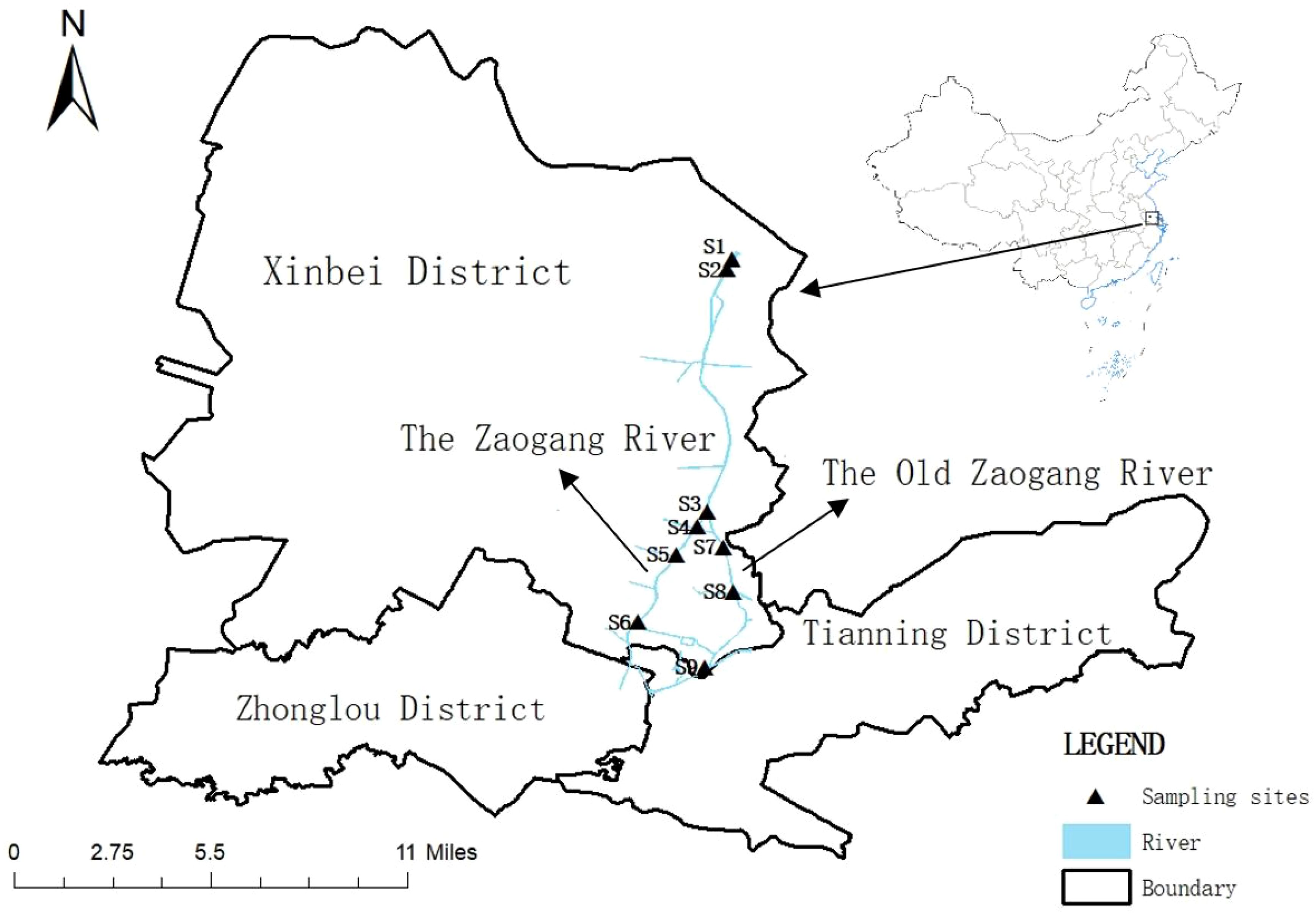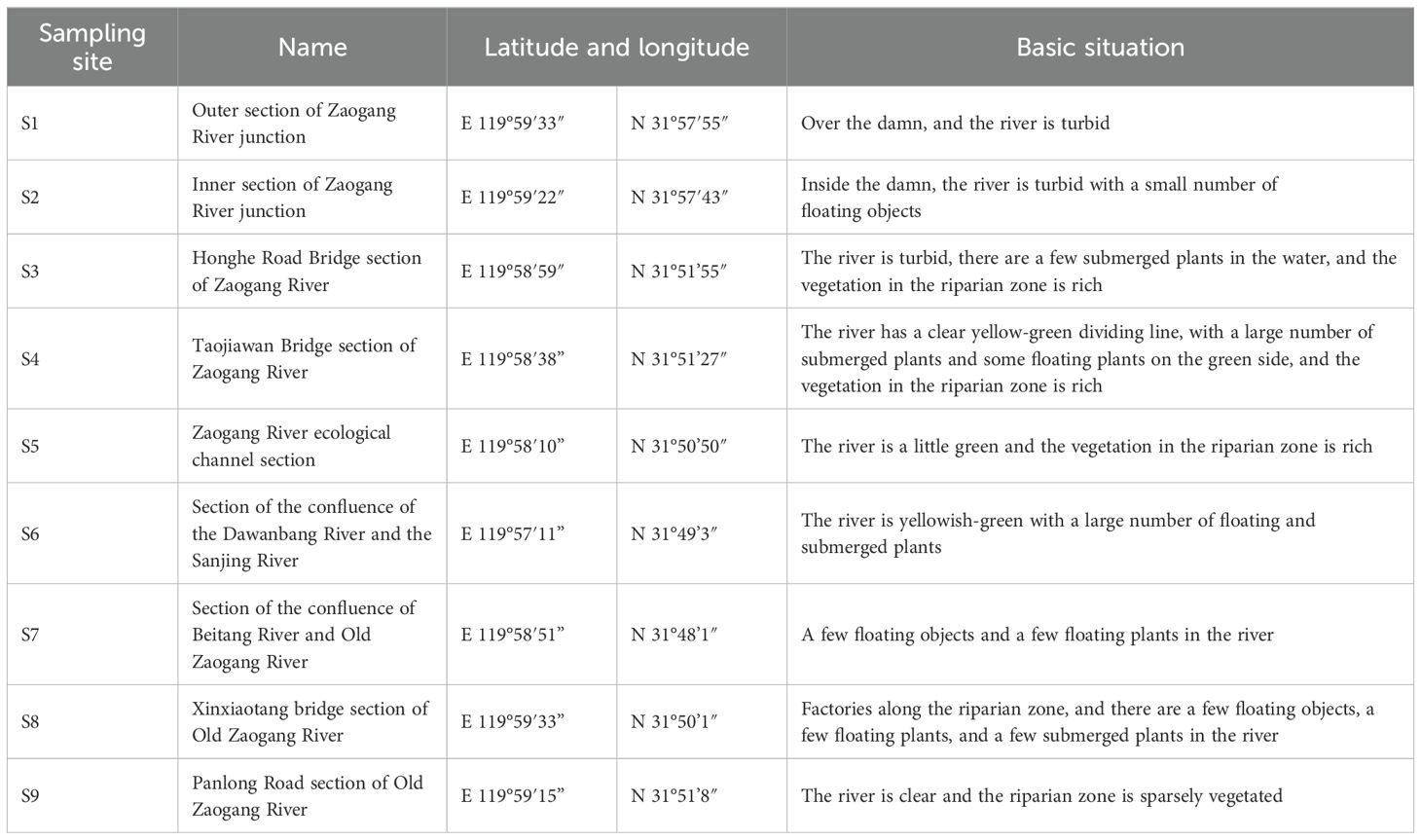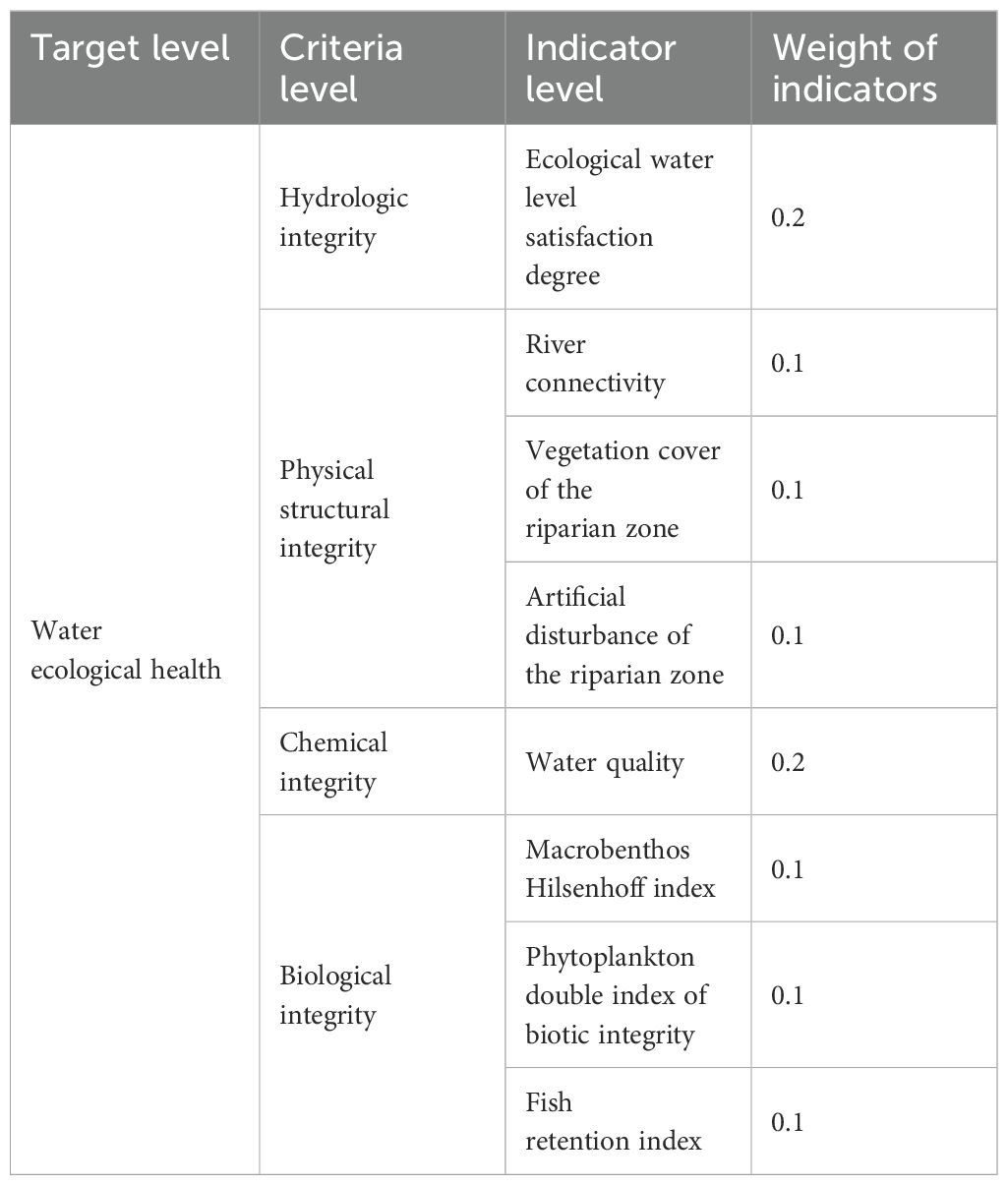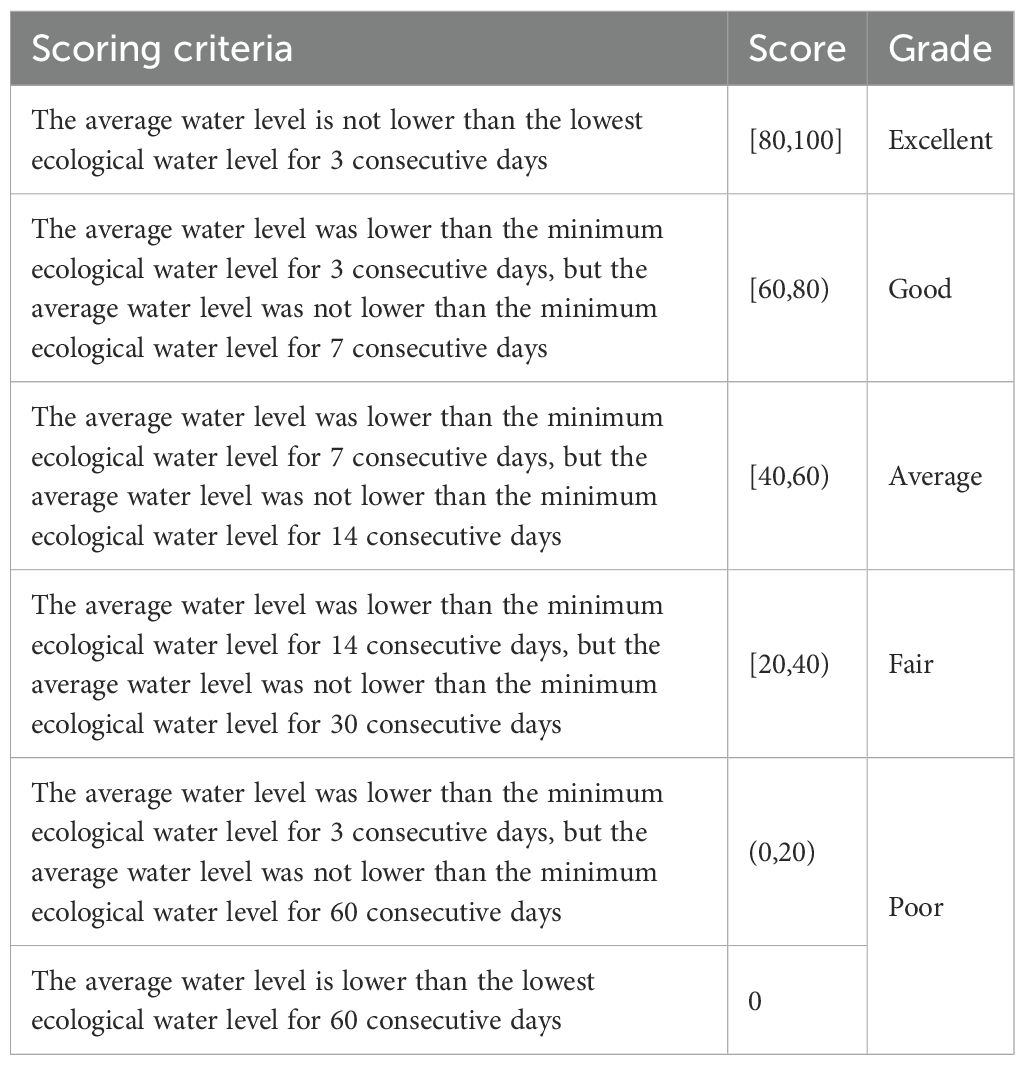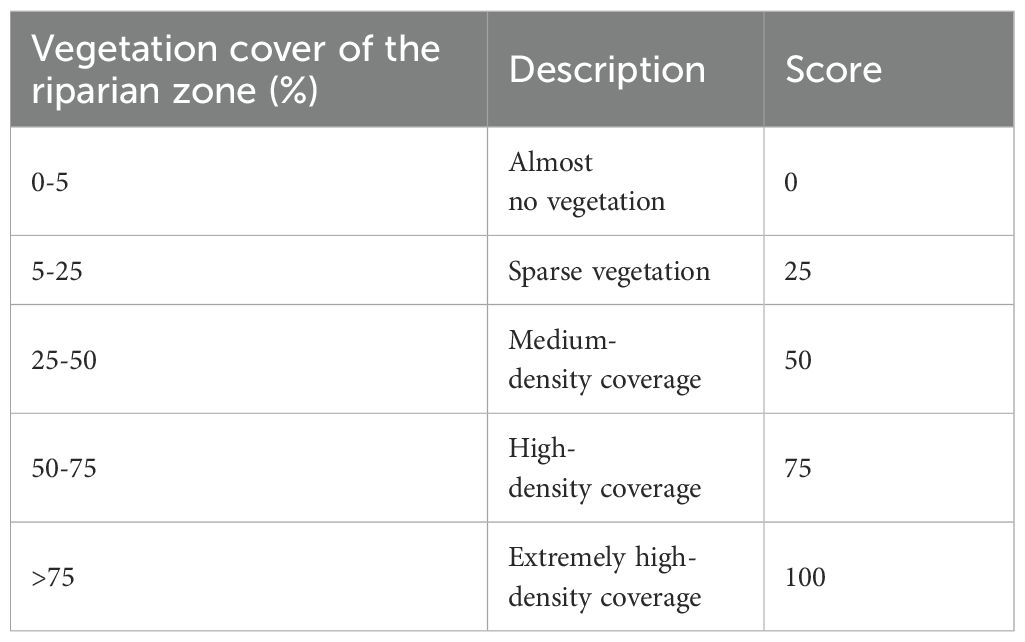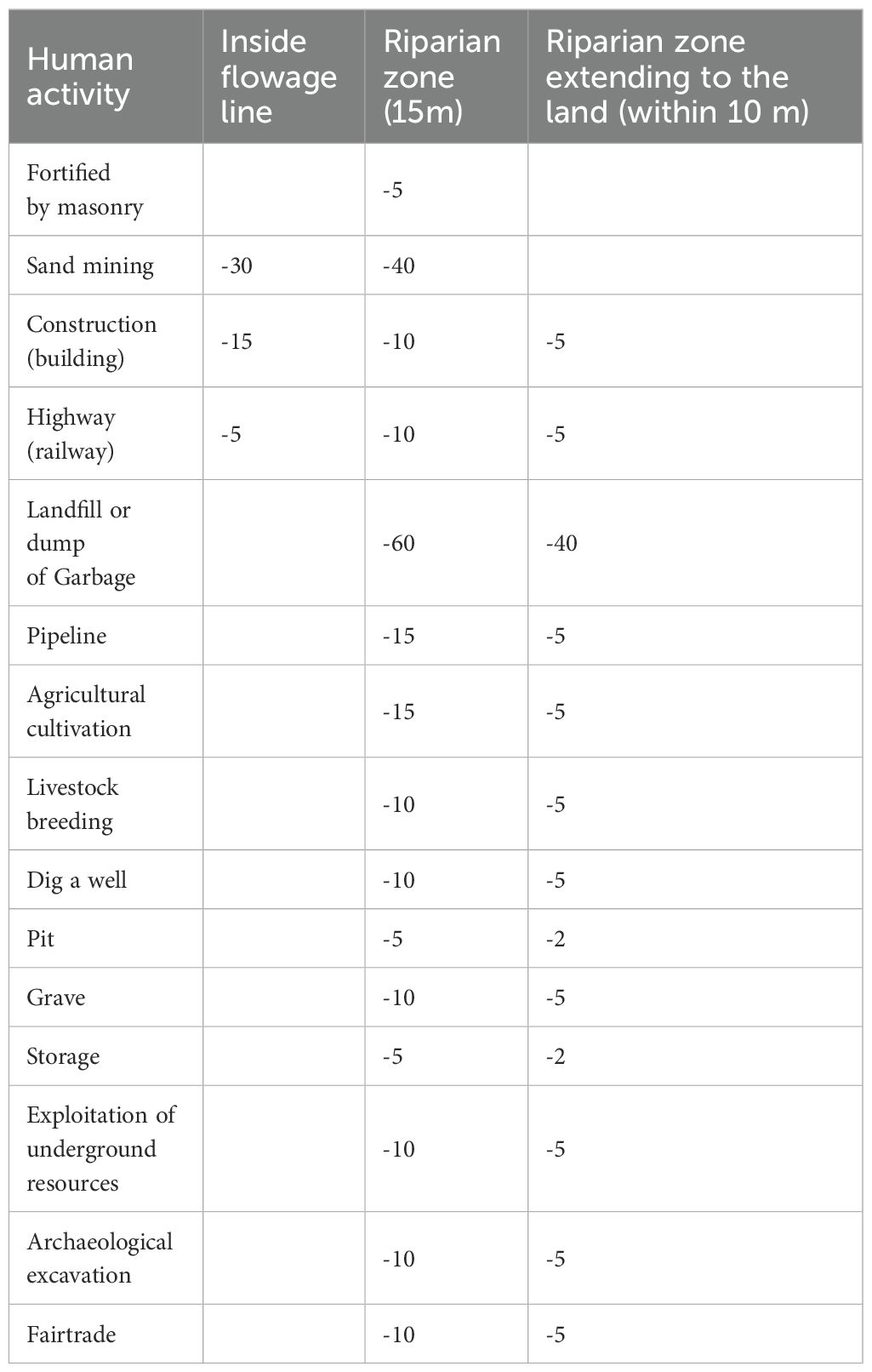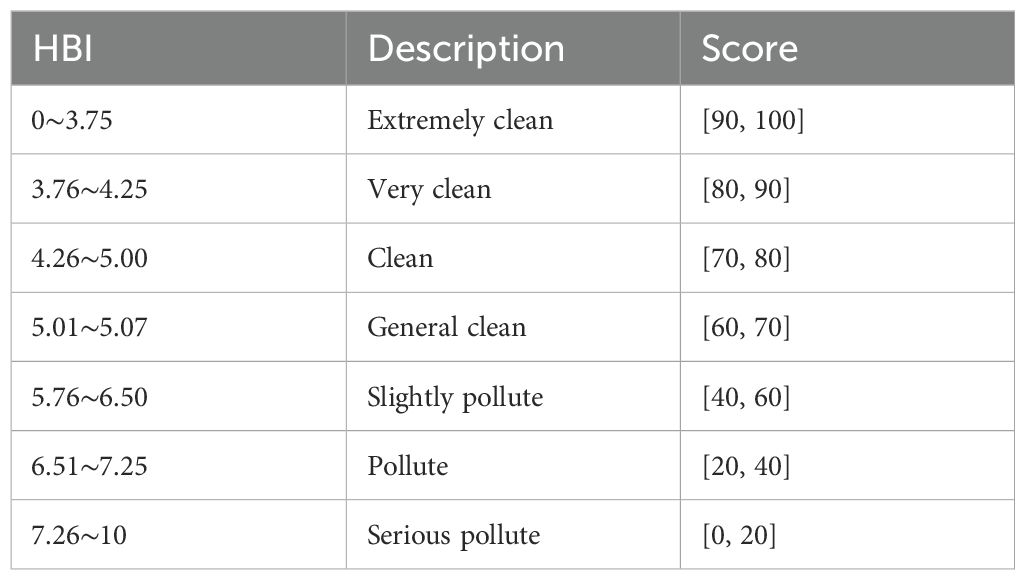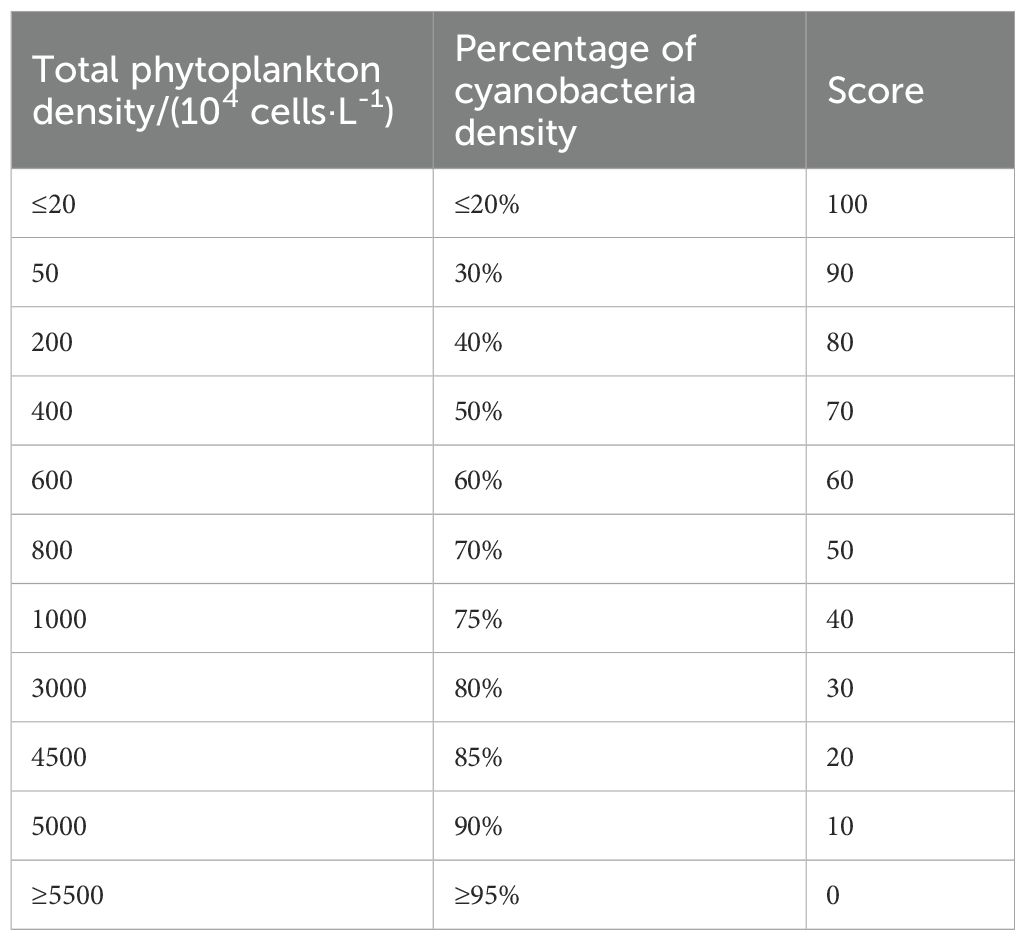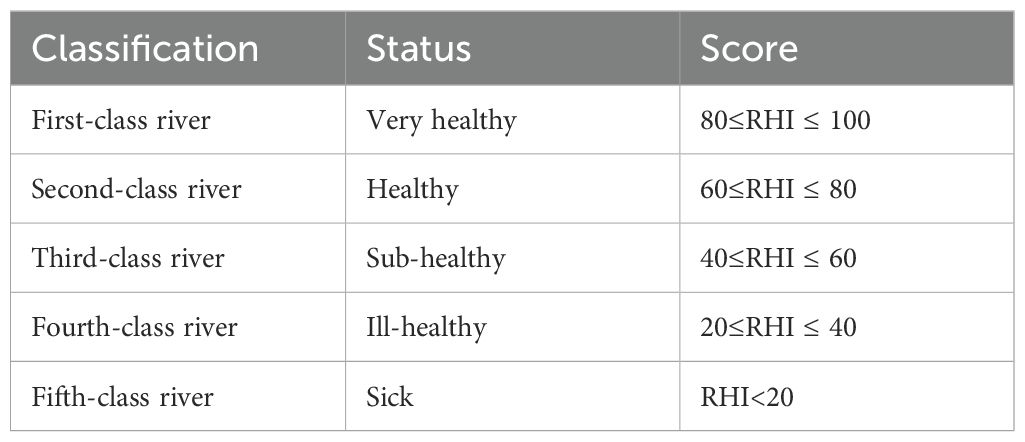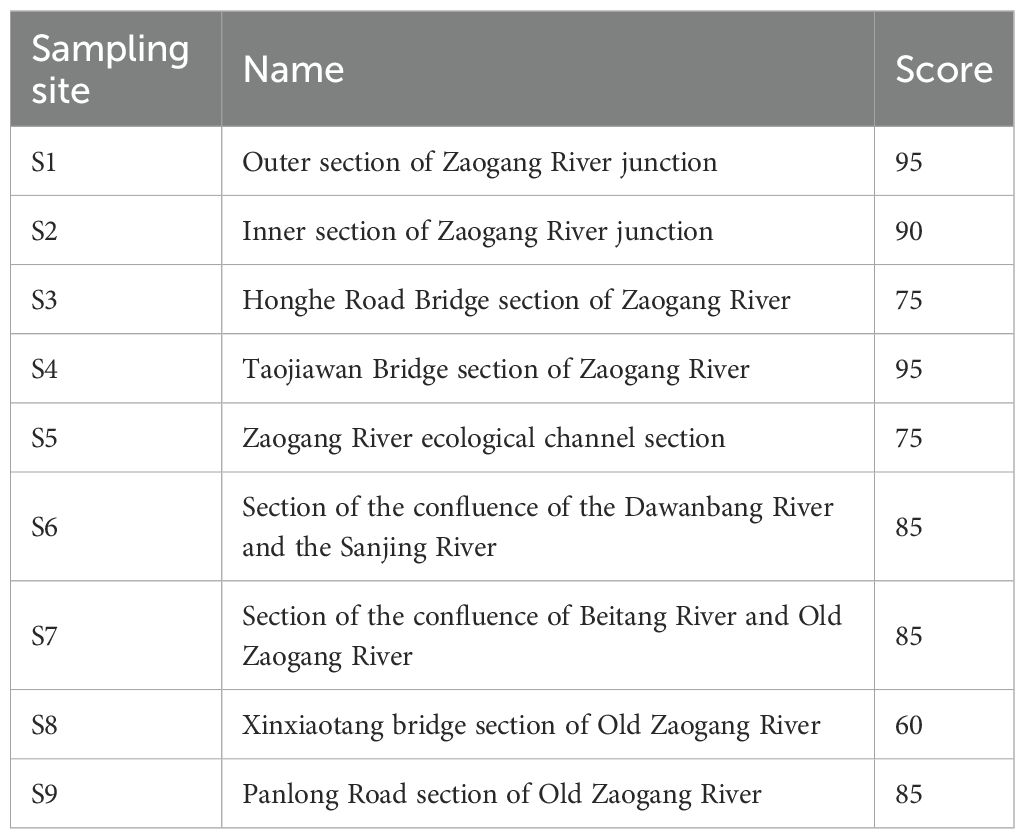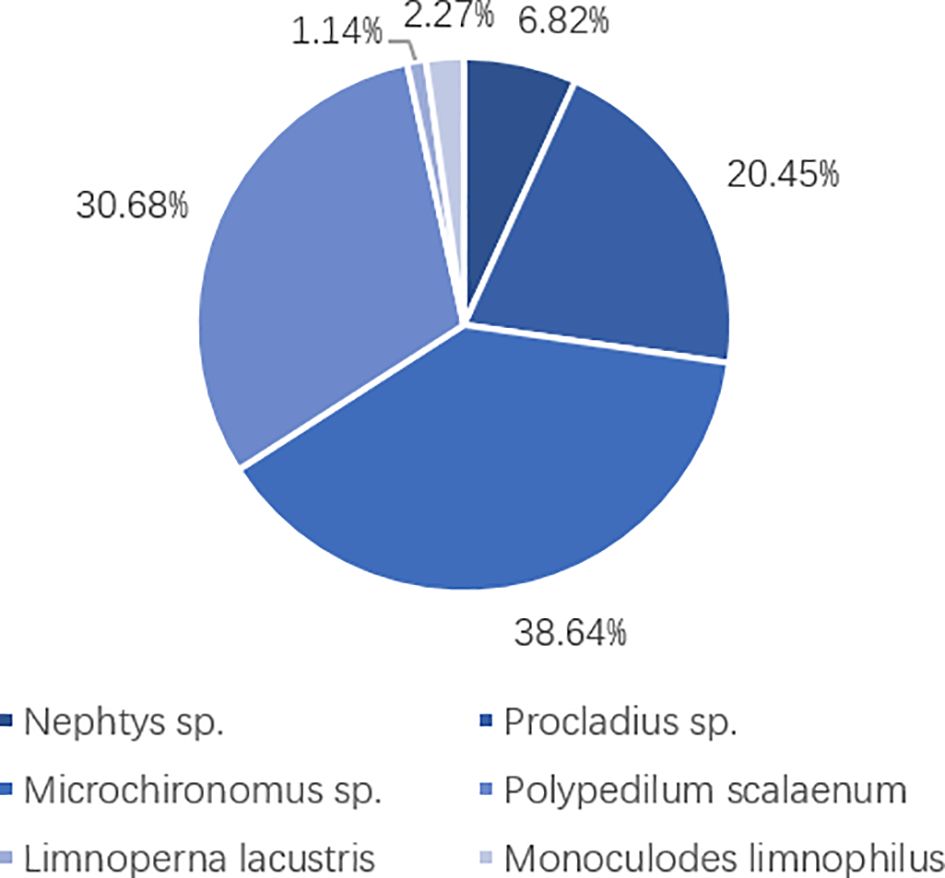- 1Key Lab of Water and Sediment Science of Ministry of Education, School of Environment, Beijing Normal University, Beijing, China
- 2Changzhou Academy of Environmental Science, Changzhou, China
The ecological health of urban rivers serves as a critical indicator of the overall health of urban ecosystems. The water ecological health status of the Zaogang River in Changzhou City was evaluated; nine sections of the river and the Old Zaogang River were sampled, and an assessment system with 8 indexes for hydrologic integrity, physical structural integrity, chemical integrity, and biological integrity was set up. A comprehensive scoring system, based on index scores and their corresponding weights, was employed to evaluate the ecological health of the Zaogang River. The assessment revealed that most sections of the Zaogang River were in a healthy state, classified as second-class level. In contrast, the Old Zaogang River exhibited sub-health conditions in one section, indicating a need for comprehensive restoration measures. Water ecological health evaluation system constructed in this study is relatively complete and comprehensive, and provides a good example for the rapid evaluation of urban rivers. Additionally, the findings of the study offer guidance for managing rivers in Changzhou city.
1 Introduction
In recent years, with the accelerated progress of industrialization and urbanization, a large amount of domestic sewage and industrial wastewater has been discharged into rivers, far exceeding the self-purification capacity of the rivers themselves. Rivers and lakes are increasingly facing ecological challenges. Preserving the health and vitality of rivers and lakes, while ensuring the sustainable use of water resources, has become a critical and urgent societal task.
The evaluation of water ecological health serves as a crucial basis for the scientific formulation of water resource allocation plans and river protection measures, providing a scientific basis for the rational utilization of water resources and ecological protection and restoration in the river basin (Stoddard et al., 2006; Poikane et al., 2020; Brosed et al., 2022). Two primary methodologies currently dominate the study of water ecological health: the comprehensive index method and predictive modeling. The comprehensive index method employs a mathematical comprehensive assessment model and a set of biological, chemical, and physical indicators to determine the overall status of water ecological health. Common methods include the Index of Stream Condition (ISC) (European Commission, 2000), Riparian, Channel, and Environmental Inventory (RCE), and Rapid Bioassessment Protocols (RBPs) (Tang et al., 2002). Predictive modeling evaluates the status of water ecological health by comparing actual river species with the species that should exist without human interference. Common methods include the Index of Biological Integrity (IBI) (Wright et al., 1984) proposed by Karr and the River Invertebrate Prediction and Classification System (RIVPACS) (Thornbrugh et al., 2018) proposed by Wright. The rapid development of monitoring technology has facilitated the measurement of river biological characteristics, structural morphology, water quality, and quantity. The comprehensive evaluation index method MMI, developed in the 1990s, enables a holistic assessment of water ecosystems (Prudente et al., 2018). MMI has a wide range of applications and can be used in many types of water bodies, such as rivers, lakes, and reservoir areas (Zhou et al., 2019; Li et al., 2021). In recent years, the evaluation system for urban river health has been gradually improved and developed (Martinez-Haro et al., 2015; Díaz et al., 2019). While focusing on aquatic organisms, abiotic elements have been incorporated into the evaluation system, making the evaluation system more perfect and comprehensive. Deng et al. (2014) built an urban water ecological health evaluation index system containing 24 indicators from three aspects, including natural ecology, social economy, and landscape environment, and established a fuzzy comprehensive evaluation model based on the analytic hierarchy process. Su et al. (2019) developed a river ecosystem health evaluation index system focusing on integrity, stability, and sustainability to explore the impact of water transfer projects on the Yangtze River ecosystems’ health. Under the guidance of the concept of resilience, Zhang et al. (2022) built an urban water ecological health evaluation index system based on the pressure-state-response model (PSR), evaluating and predicting water ecological health levels and development trends using combined weighting methods and matter-element extension models. Becker et al. (2022) used the River Ecosystem Service Index (RESI) to evaluate the service function of the ecosystem and to guide the restoration of the ecological service function of rivers to cities. Meanwhile, water ecological evaluation is to describe the physical structure, chemical state, and biological state of the water ecological system, thereby evaluating the health status of the system, identifying critical issues, and providing a basis for evaluating the effectiveness of ecological restoration measures and adjusting policies and regulations (Zhang et al., 2023). In this study, a rapid evaluation system for water ecological health was established by combining the predictive modeling method and comprehensive index method, integrating the advantages of both methods and aiming to identify the key issues of urban rivers in Changzhou, thereby providing guidance for relevant policies for water ecological health protection.
Changzhou, located in the Taihu Lake basin, boasts a well-developed plain river network. Changzhou has attached great importance to water ecological health in recent years. In 2014, the city established the water ecological health evaluation index system by referencing the Indicators, Standards, and Methods of River Health Assessment and the assessment report of important rivers in Jiangsu Province, and combining the specific conditions of the city. Based on the various characteristics and functions of rivers, a single-factor evaluation of water ecological health status is carried out using 14 indicators, including physical, chemical, ecological characteristics, and social service functions. On this basis, the natural and social attributes of rivers are further evaluated, and the health status of rivers is comprehensively evaluated. In 2019, Changzhou renamed “River and Lake Health Assessment” to “River and Lake Ecological Status Assessment,” aligning with the local standard of Jiangsu Province, Ecological Assessment of River and Lake (Water Resources Department of Jiangsu Province, 2019). Based on the hydrological and ecological characteristics of the city rivers, the “phytoplankton” index in aquatic organisms has been adjusted to “zooplankton and benthic animals,” and the original two indicators of “aquatic organisms” have been increased to three, while the total weight coefficient of “aquatic organisms” remains unchanged. It includes 13 indicators from 5 aspects: water security, aquatic organisms, aquatic habitat, water space, and public satisfaction (Ji et al., 2020).
As a multifunctional river in Changzhou, China, the Zaogang River plays a vital role in water transfer to the Yangtze River. Therefore, evaluating its water ecological health status is of utmost importance. In this study, the assessment of the water’s ecological health status is conducted to establish a scientific understanding of the river’s ecological condition and provide a basis for effective river management.
2 The research area and data
2.1 Overview of the research area
Changzhou is located in the northwest of the Taihu Lake Basin, bordering the Yangtze River in the north, Taihu Lake in the south, and the Jinli hills and mountains in the west. Reservoirs and dams are dotted all over the place, with plains and polders situated between the rivers in the north and the lakes in the south. The river system is highly developed, forming a complete network. Renowned as the “Jiangnan water town,” Changzhou’s Zaogang River is one of its significant backbone rivers, connecting with the Yangtze River in the north and the Guan River in the south, ultimately leading to the Dawanbang River. Stretching 20.2 kilometers in length, the Zaogang River serves multiple functions, including flood control, drainage, irrigation, water supply, ecological balance, and navigation in the west of the Wuchengxi region. There are many tributaries of the river, and the dredging project was completed in 1996. The upstream, in Yutang town, has been curved and straightened, and the downstream has been diverted into two streams in Huzhuang, north of Longhutang. One stream flows southwest along the river through Changzhou High-tech Zone into the Guan River, while the other flows southeast along the east branch of the Old Zaogang River through the Yonghui River to the Beitang River, and ultimately reaches the Grand Canal through the tributaries such as the Hengtang River, Dingtang Port, and Sanshan Port. Some parts of the river flow into Jiangyin (Zhong, 2013). The locations of the Zaogang River and the Old Zaogang River are shown in Figure 1.
2.2 Data source and processing
River macrobenthos, ecological water level satisfaction degree, and phytoplankton double index of biotic integrity use the data from Changzhou Academy of Environmental Science. The data on vegetation cover, artificial disturbance of the riparian zone, and river connectivity are obtained through the interpretation of Orvital satellite images. More information can be found at https://www.ovital.com.
3 Methods
3.1 Set of sampling sites
The sampling and investigation of the water quality was conducted on September 23 and 24, 2023, for detailed ecological and environmental analysis of the Zaogang River in Xinbei District, Zhonglou District, and Tianyu District, Changzhou City, Jiangsu Province, China. As a key water resource in this region, the Zaogang River system is comprised of two main sections: the Zaogang River and the Old Zaogang River. The core objective of this survey is to obtain the latest and accurate data to ensure the typicality and timeliness of the analysis results. Therefore, in order to avoid that the local conventional monitoring points usually selected cannot represent the ecological status of the whole river, the local conventional monitoring points were avoided in the selection of sampling points, and multiple sampling sites were set up along the river, hoping to fully reflect the ecological status of the Zaogang River.
Sampling sites were strategically selected at critical points along the river, including its headwaters, midsection, and terminus, as well as at the confluences of tributaries and key dam locations. The sampling sites extend from the outer section of the Zaogang River Junction to the section after the intersection of the Dawanbang River and the Sanjing River. The Zaogang River is a smaller urban river, but multiple sampling sites were still set up, with the points spaced at an appropriate distance and having a certain degree of representativeness. The river length represented by the sampling sites is considered to be able to cover both the Zaogang River and the Old Zaogang River, so it is believed that the sampling sites can represent the ecological condition of the river. To minimize external interference factors, careful observations are carried out at least 500 meters upstream of each sampling site to avoid areas that may affect the physical and chemical properties of the river, such as industrial sewage outfalls, livestock manure accumulation points, and household garbage dumping areas. Taking into account the water quality, water quantity, and coastal discharge status of the Zaogang River, 9 sampling sites are selected (Figure 1), among which 6 are along the Zaogang River and 3 along the Old Zaogang River. The latitude and longitude coordinates and the basic description of each sampling site are shown in Table 1. The distance between S1 and S2 is relatively short; however, S1 is situated outside the Zaogang River junction while S2 lies within it. Analyzing the ecological conditions of S1 and S2 can provide insights into how the junction influences the river’s ecological status to some extent. Meanwhile, S3 is positioned at the confluence of the Zaogang River and the Old Zaogang River, serving as a valuable reference for comparing ecological conditions between these two rivers. The remaining sampling sites are located where both rivers converge, making them representative and significant.
Stainless steel water quality samplers are used for sampling. For sites S1, S2, S3, S7, and S8, the sampler is dropped vertically from the bridge, with sampling locations primarily in the middle of the river. The sampling locations for the remaining sites are 1-2 meters away from the riparian zone, and the depth of sampling is approximately 1 meter below the river’s surface.
3.2 Sample analysis method
The indicators of water quality investigation are comprised entirely of indoor detection indicators, including COD (mg/L), NH3-N (mg/L), TP (mg/L), TN (mg/L), Pb (mg/L), and Electrical conductivity (μs/cm). The GW-2000E portable multi-parameter water quality tester is used for determination, while the DIS-1D portable digester facilitates the digestion process.
3.3 Evaluation methods
3.3.1 Evaluation principles
Based on the acquired data, an evaluation system is constructed to evaluate the water ecological health status of the Zaogang River, focusing on four criteria levels: hydrologic integrity, physical structural integrity, chemical integrity, and biological integrity. Considering the impact of dams on the Zaogang River, assessing its flow holds little significance. Dams have a relatively important impact on river connectivity to a certain extent, thus the indicators of hydrological integrity are selected as the ecological water level satisfaction degree and river connectivity. The Zaogang River is a typical urban river greatly affected by human activities, making it crucial to evaluate vegetation cover and artificial disturbance of the riparian zone. Benthic animals and phytoplankton are sensitive to environmental changes and can indicate the cleanliness and ecological status of water bodies to a certain extent. Fish, at the top of the nutrient level in the water ecosystem, play a vital role in representing the water environment’s stability. Therefore, indicators of biological integrity such as Hilsenhoff index, phytoplankton double index, and fish retention index were selected for assessment purposes. The determination of index weights is based on the “Technical guidelines for river and lake health assessment” (Ministry of Water Resources of the People’s Republic of China, 2020). Table 2 presents the specific indicators along with their respective weights.
3.3.2 Ecological water level satisfaction degree assessment methods
Urban rivers have varying degrees of ecological functions. The essence of river ecological levels and ecological discharge is that both water quantity and quality must be simultaneously satisfied to maintain the normal development of diverse ecological functions. However, because urban rivers are controlled by sluices and dams, they affect river connectivity and, consequently, river discharge. Therefore, the index of river ecological discharge satisfaction is used instead of the river ecological water level satisfaction. The scoring criteria are shown in Table 3.
3.3.3 River connectivity assessment methods
River connectivity is an important parameter to measure the degree of correlation among each part of the river (Amoros and Roux, 1988), and maintaining connectivity is of great significance and thus crucial for river integrity (Wang et al., 2019). As the Zaogang River is a typical urban river, its connectivity is vulnerable to human interference. Therefore, investigating the number of artificial dams and other blocking facilities along the river is crucially important for evaluating its hydrological integrity.:
where A is the connectivity index of the river (pieces/10km), NB is the number of facilities affecting river connectivity (pieces), and L is the length of the river (km).
The score is assigned according to A, and Table 4 presents the detailed scoring criteria used in the assessment.
3.3.4 Vegetation cover of the riparian zone assessment methods
According to the “Guidelines for River and Lake Health Assessment” (Department of River and Lake Management, 2020), two 10m×10m quadrates on both sides of the riparian zone of each site are selected to calculate the vegetation cover using the following calculation formula:
where PCr is the vegetation cover of the riparian zone, Aci is the vegetation coverage area (km2) of the riparian zone i, and Aai is the area (km2) of the riparian zone i. Scoring is performed according to PCr, and the scoring criteria and the description are shown in Table 5.
3.3.5 Artificial disturbance of the riparian zone assessment methods
Located in the main urban area of Changzhou City, the Zaogang River is closely intertwined with urban life and is susceptible to disturbance by human activities. Therefore, evaluating the degree of artificial disturbance is essential. Utilizing remote sensing maps and other tools, we conduct investigations to ascertain the presence of 15 typical human activities within the riparian zone and its adjacent land areas. Following this, the degree of artificial disturbance is assessed. The scoring criteria is based on the “Technical guidelines for river and lake health assessment” (Ministry of Water Resources of the People’s Republic of China, 2020). The scoring criteria for this assessment are detailed in Table 6.
3.3.6 Water quality assessment methods
The single-factor evaluation method is employed for each water quality index. Afterward, these indices are synthesized to obtain a comprehensive evaluation of water quality at the sampling site. Measured concentrations of COD, ammonia nitrogen, total phosphorus, total nitrogen, and Pb are rated according to the standard values specified in the “Environmental Quality Standards for Surface Water” (Ministry of Ecology and Environment of the People’s Republic of China, 2002). The water quality category of the worst-performing parameter is then taken as representative of the water quality category for each sampling site of the Zaogang River. A comprehensive evaluation of the water quality category is subsequently determined.
Each water quality index for each sampling site undergoes linear interpolation against the scoring threshold to derive the scoring value. The scoring criteria are detailed in Table 7. It is assumed that each index is of equal importance, so the water quality index for each sampling site is determined by calculating the average of the values.
3.3.7 River macrobenthos assessment methods
Macrobenthos are important components of water ecosystems. They are sensitive to environmental changes and have weaker migration abilities than other aquatic animals. Therefore, compared with fish and plankton, macrobenthos can better represent the level of pollution in the water environment (Riato et al., 2020). The assessment of river macrobenthos is based on data provided by the Changzhou Academy of Environmental Science, with the monitoring section designated as the No. 9 Bridge section. The Hilsenhoff index (HBI) can be briefly explained as a measure of the sensitivity of macrobenthos in rivers to organic pollution. The Hilsenhoff index is used to evaluate the water quality of these sections, leveraging the varying sensitivity or tolerance of different macrobenthos to organic pollution and the abundance of information on different groups. The evaluation formula is as follows:
where ni is the number of individuals of the I th taxon, N is the total number of sample individuals, and it is the tolerance value (TV) of the I th taxon.
The tolerance values of macrobenthos refer to the “aquatic organism monitoring and evaluation of rivers” (Ministry of Ecology and Environment of the People’s Republic of China, 2023). The corresponding score table and description of HBI values are shown in Table 8.
3.3.8 Phytoplankton double index of biotic integrity assessment methods
Phytoplankton is sensitive to changes in environmental factors, and changes in its abundance and community composition can often represent changes in the water environment, especially for relatively static water bodies. The Zaogang River is an urban river, and its flow rate is relatively slow. The community structure of phytoplankton can well represent the quality of the water environment. The monitoring section is the No. 9 Bridge section. Biological indicators are evaluated by the percentage of cyanobacteria density and total phytoplankton density (Zhang et al., 2024). The evaluation formula is as follows:
where CPD is the standardized value of total phytoplankton density, CCP is the standardized value of the percentage of cyanobacteria density, and PDIBI is the phytoplankton biodiversity index. The standardization method of the P-DIBI index is shown in Table 9.
3.3.9 Fish retention index assessment methods
Fish plays a crucial role in the water ecosystem, occupying the top position in the nutrient structure and contributing to its overall stability. Changes in fish species can serve as an indicator of the long-term ecological health of a river. The evaluation of the fish retention index is based on data provided by Changzhou Academy of Environmental Science. Due to the unavailability of historical data for Zaogang River, the Changzhou section of Jing-Hang Grand Canal was selected as a reference point for evaluation (Qin et al., 1988). The Jing-Hang Grand Canal and the Zaogang River are the main urban rivers in Changzhou city, sharing similar characteristics during this period. Therefore, it is considered that Jing-Hang Grand Canal can be used as a reference point for evaluating fish retention index to some extent. The calculation formula is as follows:
Where FOEI is fish retention index (%), FO is the number of fish species obtained from the river survey, and FE is the number of fish species in the 1980s.
3.3.10 Comprehensive assessment methods
Based on the corresponding weights and scores of each indicator at each sampling site, a comprehensive score for each site is obtained. The calculation formula is as follows:
where RHI is the comprehensive score of each sampling site, as is the I index, and bi is the score assigned to the I index.
According to the comprehensive scores of each sampling site, the water ecological health status of each sampling site is determined, and the water ecological health assessment classification table is shown in Table 10.
4 Results
4.1 Ecological water level satisfaction degree results
According to the “Water Ecological Protection Target Plan of Changzhou City”, the lowest ecological water level at the main control section in Changzhou City is 3.44 meters. The average water levels of the Zaogang River, measured at 1.59 meters, 1.54 meters, 1.84 meters, and 1.72 meters on four consecutive days from February 19 to 22, were all below this threshold. Consequently, the Zaogang River received a score of 75 for ecological water level satisfaction, which indicates a good level of ecological water level satisfaction.
4.2 River connectivity results
Utilizing remote sensing maps, we investigated the artificial facilities, such as dams, along the Zaogang River and the Old Zaogang River. The presence of two dams along the Zaogang River results in a connectivity index of 1.40, reflecting moderate disruption in river continuity. In contrast, there is only one artificial facility along the Old Zaogang River, yielding a higher connectivity index of 2.28, which suggests reduced river connectivity and, by extension, hydrological integrity compared to the Zaogang River. The evaluation and scoring of river connectivity were conducted using linear interpolation, with the detailed results presented in Table 11.

Table 11. Results of river connectivity, showing that the situation of the Old Zaogang River is worse.
4.3 Vegetation cover of the riparian zone assessment results
The assessment included nine representative sites: the outer section of the Zaogang River junction (S1), the inner section (S2), the Honghe Road Bridge section (S3), the Taojiawan Bridge section (S4), the ecological channel section (S5), the section at the confluence of the Dawanbang and Sanjing Rivers (S6), and three sections along the Old Zaogang River, namely the section at the confluence with the Beitang River (S7), the Xinxiaotang Bridge section (S8), and the Panlong Road section (S9). These last three sites are part of the Old Zaogang River. The evaluation results for all sites are detailed in Table 12.
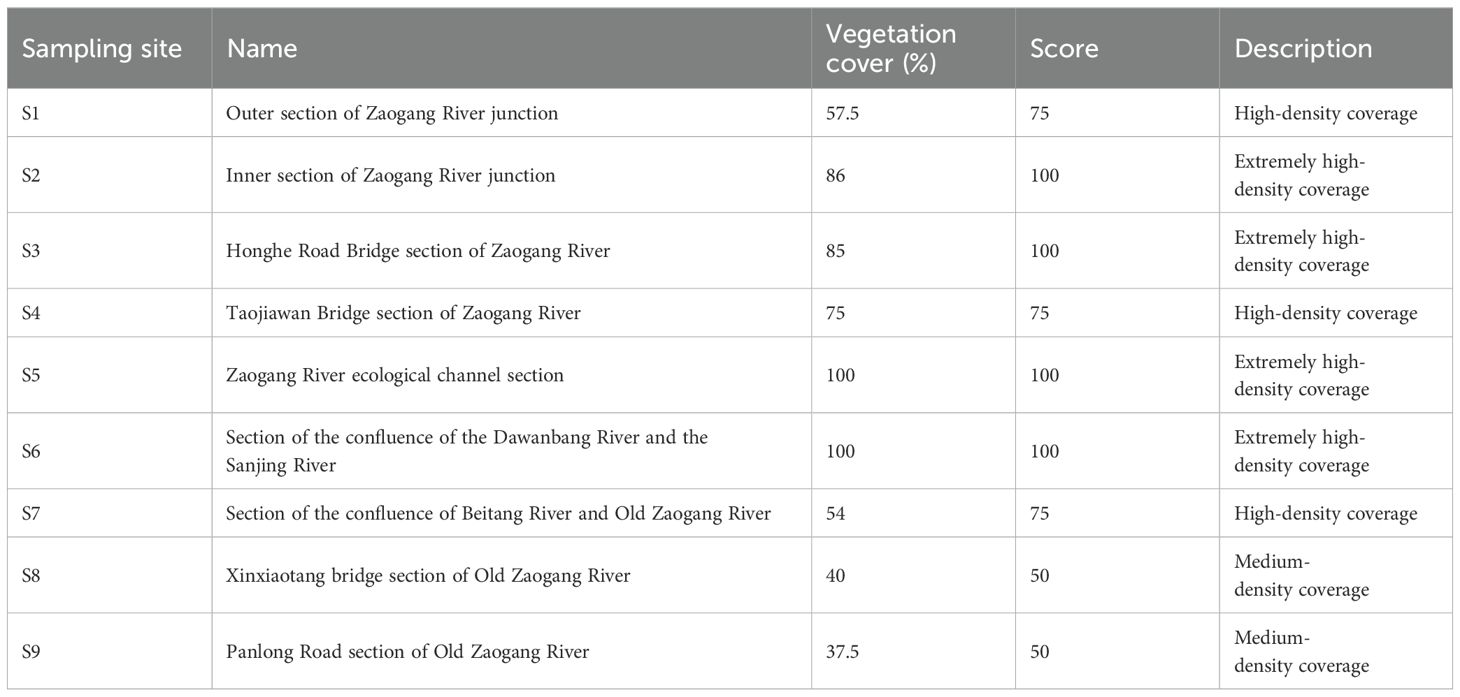
Table 12. Results of vegetation cover, indicating the vegetation cover performs great especially in the Zaogang River.
The riparian zone along the Zaogang River was characterized by high-density vegetation cover, with the Taojiawan Bridge section (S4) and the ecological channel section (S5) showing an exceptionally high level of 100% coverage. In contrast, the Old Zaogang River has significantly lower vegetation cover. The Xinxiaotang Bridge section (S8) and the Panlong Road section (S9) are notably below the 50% mark, indicating medium-density coverage. The vegetation cover at the confluence of the Beitang River and the Old Zaogang River (S7) slightly exceeds 50% and is considered high-density coverage. The overall vegetation cover of the riparian zone of the Old Zaogang River requires improvement.
4.4 Artificial disturbance of the riparian zone assessment results
Using remote sensing maps, we investigated the presence of various artificial disturbance activities in the riparian zone of the Zaogang River. Additionally, the degree of artificial disturbance for both the Zaogang River and the Old Zaogang River was evaluated. The findings of this assessment are detailed in Table 13.
The degree of artificial disturbance along the Zaogang River and the Old Zaogang River is as follows: all sections of the Zaogang River (S1, S2, S3, S4, S5, S6) feature masonry fortifications. Constructions extend into the riparian zone and land areas, particularly at the inner section of the Zaogang River junction (S2). The Honghe Road Bridge section (S3) includes coastal constructions and pipelines within the riparian zone. Along the ecological channel section of the Zaogang River (S5), constructions are present, and highways or railways are observed. Similarly, the riparian zone at the confluence of the Dawanbang River and the Sanjing River (S6) features highways or railways. In summary, the outer section at the Zaogang River junction (S1) and the Taojiawan Bridge section (S4) exhibit low levels of artificial disturbance. However, the Honghe Road Bridge section (S3) and the ecological channel section (S5) show high degrees of artificial disturbance, with typical human activities such as masonry fortifications, construction, and highways or railways in the riparian zone and adjacent land.
The Old Zaogang River exhibits a higher degree of artificial disturbance across all sections (S7, S8, S9), characterized by masonry fortifications and the presence of highways or railways. Notably, the riparian zone of the Xinxiaotang Bridge section (S8) also features coastal structures and pipelines. Overall, the Old Zaogang River, particularly section S8, experiences significant human activity interference, including masonry fortifications, construction, highways, railways, and pipelines.
Artificial disturbances are present to varying extents in both the Zaogang River and the Old Zaogang River, with each section showing different degrees of disturbance. Comparatively, the Zaogang River fares better in terms of lower disturbance levels. Nonetheless, enhanced management and protection measures are essential to mitigate the negative impacts on the riparian zones and the adjacent lands of both rivers.
4.5 Water quality assessment results
According to the results of water quality experiments, both the Zaogang River and the Old Zaogang River primarily fall within Class V, signifying poor water quality. The primary pollution factors include total nitrogen, lead (Pb), and chemical oxygen demand (COD). The COD levels across the sampling sites range from Class II to Class V, revealing notable variability. Among these, the more significant pollutants are COD and Pb. This may be attributed to the fact that the Zaogang River and the Old Zaogang River are typical urban rivers with a high level of human activity in their vicinity. Additionally, there are several factories and enterprises located nearby, leading to higher concentrations of COD and Pb in both the Zaogang River and the Old Zaogang River. The detailed assessment results, including these findings, are presented in Table 14.

Table 14. The main pollution indicators at each sampling point in the Zaogang and Old Zaogang rivers, highlighting the difference in COD and total nitrogen concentrations.
Each water quality index is analyzed separately, with the results reflecting the changes in ammonia nitrogen concentration along each section of the Zaogang River. Notably, with the exception of the section of the confluence of Beitang River and Old Zaogang River (S7), which has a high ammonia nitrogen concentration of 1.01 mg/L and is classified as Class IV, the water quality in other sections is classified as Class II.
Additionally, the COD concentration at Section S4, located at the Taojiawan Bridge (50.7 mg/L), significantly exceeds the standard, resulting in surface water quality that is classified below Class V. This may be due to the presence of tributaries in this section, which has a higher COD concentration, thus affecting the COD concentration of the river. Similarly, the COD concentrations in the outer section of the Zaogang River junction (S1) at 30.65 mg/L, the inner section of the Zaogang River junction (S2) at 38.8 mg/L, and the Honghe Road Bridge section (S3) at 31.75 mg/L, are also extremely high, all categorized as Class V water quality. In contrast, the COD concentration at the Xinxiaotang Bridge section of the Old Zaogang River (S8), while relatively high at 22.1 mg/L, corresponds to a Class IV water quality rating. However, the remaining sections adhere to Class II water quality standards.
It is evident that the concentration of total nitrogen at the Panlong Road section of the Old Zaogang River (S9) is alarmingly high at 2.11 mg/L, resulting in water quality worse than Class V. Additionally, the concentrations at the Zaogang River ecological channel section (S5) with 1.73 mg/L, the confluence of the Dawanbang River and the Sanjing River (S6) at 2 mg/L, and the confluence of the Beitang River and the Old Zaogang River (S7) at 1.87 mg/L, are also high, all classified as Class V water quality. Slightly high concentrations, corresponding to Class IV water quality, are found in the outer section of the Zaogang River junction (S1) at 1.3 mg/L, the Taojiawan Bridge section (S4) at 1.42 mg/L, and the Xinxiaotang Bridge section of the Old Zaogang River (S8) at 1.27 mg/L. The remaining sections have low total nitrogen concentrations, meeting Class III water quality standards.
On the other hand, in terms of total phosphorus concentration, that certain sections, specifically the inner section of the Zaogang River junction (S2) at 0.11 mg/L, the confluence of the Dawanbang River and the Sanjing River (S6) at 0.11 mg/L, the confluence of the Beitang River and the Old Zaogang River (S7) at 0.14 mg/L, and the Xinxiaotang Bridge section of the Old Zaogang River (S8) at 0.11 mg/L, all adhere to Class III water quality standards. The remaining sections perform better, meeting Class II water quality standards.
At the same time, the Pb concentrations in the Xinxiaotang Bridge section of the Old Zaogang River (S8) at 0.12 mg/L and the Panlong Road section of the Old Zaogang River (S9) at 0.15 mg/L seriously exceeds the standard, indicating water quality that is worse than Class V. The Pb concentration in the outer section of the Zaogang River junction (S1) at 0.09 mg/L and the confluence of the Beitang River and the Old Zaogang River (S7) at 0.09 mg/L is also extremely high, classified as Class V water quality. Other sections comply with Class III water quality standards.
Electrical conductivity, on the other hand, shows minimal variation, consistently ranging from 90 to 200 μs/cm. Notably, the sections at the confluence of the Dawanbang River the Sanjing River, and the Panlong Road section of the Old Zaogang River, exhibit relatively high electrical conductivity, measuring 210.6 μs/cm and 188.9 μs/cm, respectively. Conversely, the Honghe Road Bridge section and the Taojiawan Bridge section of the Zaogang River show relatively low electrical conductivity, at 91.2 μs/cm and 90.6 μs/cm, respectively.
4.6 River macrobenthos assessment results
The macrobenthos in the Zaogang River mainly belong to Chironomidae, with a few specimens belonging to Monoculodes limnophilus, and some belonging to Limnoperna lacustris and Nephtys. The specific distribution is shown in Figure 2.
The Hilsenhoff index of the Zaogang River is 4.26, corresponding to clean water quality, and the linear interpolation score is 80.
4.7 Phytoplankton double index of biotic integrity assessment results
Phytoplankton in the Zaogang River include Bacillariophyta, Chlorophyta, Chrysophyta, Cryptophyta, and Cyanophyceae, with the majority being Cyanophyceae, which account for 92% of the total phytoplankton. Cyanobacteria, or Cyanophyceae, are common harmful algae known for producing the most algal toxins. Their dominance among the phytoplankton suggests a certain degree of eutrophication in the Zaogang River, indicating significant pollution. The specific distribution of phytoplankton is detailed in Figure 3. The standardized value for total phytoplankton density is 86.53, the standardized value for the percentage of Cyanophyceae density is 5.64, and the phytoplankton biodiversity index stands at 62.27.
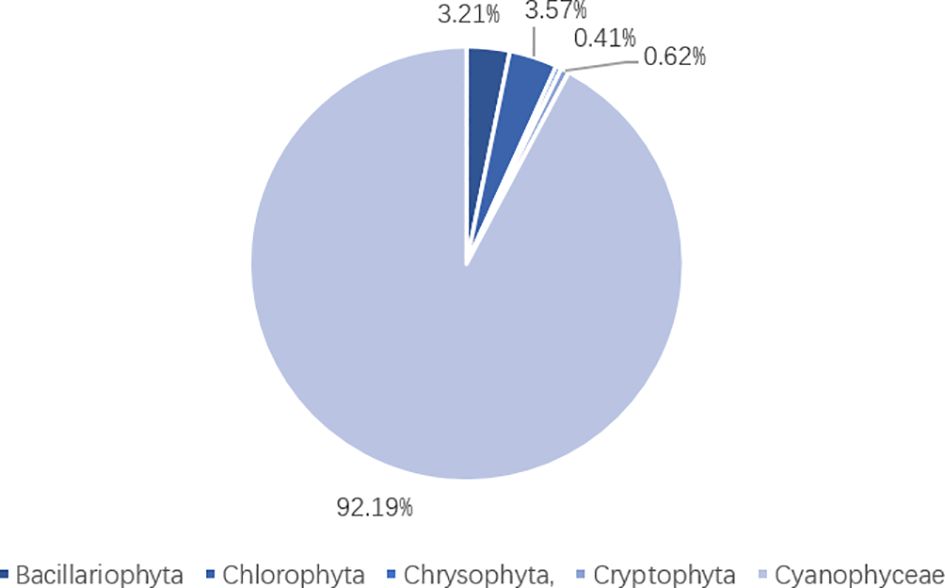
Figure 3. Distribution proportion of phytoplankton, which shows that the number of Cyanophyceae is at most.
4.8 Fish retention index results
Eight species of fish were monitored in the Zaogang River, with the dominant species being crucian carp, grass carp, and minnow. Additionally, five minor species including the flower loach, loach, Chinese paracobitis, triangular bream, and blunthead bream were also detected. Compared with the monitoring results from the 1980s, the number of species detected has significantly decreased, and some new species, such as minnow, blunthead bream, flower loach, and Chinese paracobitis, have been introduced. This indicates that the ecological condition of the river has undergone significant changes. Compared with the 1980s, the health status has declined significantly and new species have been introduced. The scoring result is 14.81 points. The extremely low score of the fish conservation index may be partly due to the significant changes in water quality of the Zaogang River compared to the reference point, with a noticeable decrease in cleanliness, and partly due to the slow flow rate of the Zaogang River and the impact of sluice dams on river connectivity, which are not conducive to fish reproduction.
4.9 Comprehensive assessment results
A comprehensive score is obtained by comprehensive evaluation of each index of each sampling site, and the results are shown in Table 15.
The analysis is based on the scores of various sections of the Zaogang River and the Old Zaogang River. The Zaogang River’s overall condition is slightly better than that of the Old Zaogang River, yet neither is ideal. The comprehensive scores for all the sections (S1, S2, S3, S4, S5, S6) of the Zaogang River all fall within the inclusive range of 68 to 72. The “Technical guidelines for river and lake health assessment” (Ministry of Water Resources of the People’s Republic of China, 2020), places the Zaogang River in the second-class level, indicating a healthy status in terms of morphological and structural integrity, water ecological integrity, resilience against disturbance, and biodiversity. However, defects are noted, particularly in the phytoplankton biotic integrity index, river connectivity, fish retention index, and water quality score. Strengthening daily management and water quality care is essential to further enhance the river’s health status.
One sections of the Old Zaogang River are in a sub-healthy status, with unsatisfactory scores for vegetation cover, artificial disturbance, water quality, and fish retention index indicating a need for timely water environment repair to restore the Old Zaogang River to health. Among all indicators, the fish retention index performs the worst. Fish, being a vital component of the ecosystem, play a crucial role in maintaining its stability and deserve serious attention. Governance measures should be implemented to restore the diversity of fish populations and ensure the stability of aquatic ecosystems.
In 2015, the Zaogang River’s water ecological health status was assessed with a comprehensive index of 0.67, graded as ‘medium,’ with a relatively low health index for natural attributes. The river’s overall water quality was inferior, mainly due to high concentrations of ammonia nitrogen, averaging 2.27 mg/L, and 3.2% of the riparian zone was unstable. Compared to the health status in 2015, it has notably improved, transitioning from “medium” to “good”. This improvement is particularly evident in the water quality and the status of the riparian zone condition.By 2019, the Zaogang River’s overall water ecological health status had improved to ‘good’. The macrobenthos diversity score was low, indicating a less diversified river ecosystem and lower aquatic biodiversity. The vegetation cover score of the riparian zone was also low. Despite a slight decrease in overall water quality compared to 2015, the macrobenthos assessment showed improvement, and there was a significant improvement in the riparian zone’s vegetation cover. The results indicate that over the past decade, the ecological health status of the Zaogang River has significantly improved since 2019, demonstrating that comprehensive renovation efforts have had a lasting effect on the river’s ecological status.
It is noteworthy that fish were previously excluded from the health assessment of the Zaogang River. Nonetheless, fish are a crucial component of the water ecosystem, and assessing them holds significant importance. The results of the fish assessment in this study are far from satisfactory, possibly due in part to the oversight of fish in prior evaluations of water ecological health. The preservation and enhancement of fish integrity and diversity should be accorded serious attention, aiming to establish a robust and stable water ecosystem and further advance river health.
5 Discussion
In this study, nine sections of the Zaogang River and the Old Zaogang River were sampled to assess water quality indices such as chemical oxygen demand (COD), ammonia nitrogen (NH3-N), total phosphorus (TP), total nitrogen (TN), and lead (Pb). These parameters were determined using established analytical methods, including the dichromate method for COD, Nessler’s reagent spectrophotometry for NH3-N, ammonium molybdate spectrophotometry for TP, alkaline potassium persulfate digestion UV spectrophotometry for TN, dithizone spectrophotometry for Pb, and the electrochemical probe method.
According to the ‘Environmental Quality Standards for Surface Water,’ the obtained indices were scored using linear interpolation. Additionally, the ecological water level satisfaction degree, Hilsenhoff index, fish retention index and phytoplankton biotic integrity index were calculated based on data provided by the Changzhou Academy of Environmental Science. Satellite maps and remote sensing data were employed to assess river connectivity, vegetation cover, and human interference levels, contributing to the establishment of an evaluation index system for assessing the ecological health status of the Zaogang River.
The results indicate that most sections of the river are in a healthy status, classified as second-class level, while the health condition of the Old Zaogang River is slightly poor, with one section in a sub-healthy status requiring comprehensive treatment.
This study assessed the aquatic ecological health of the Zaogang River across four dimensions: hydrological, biological, chemical, and physical structural integrity. Key indicators reflecting water ecological health were selected from multiple perspectives, establishing a comprehensive evaluation system for water ecological health. This system offers a scientific understanding of the Zaogang River’s health, guides further comprehensive improvement measures, and enhances the river’s ecological health across multiple dimensions. Additionally, this study provides a rapid yet rigorous framework for assessing the ecological health of urban rivers, significantly enhancing the health of urban river ecosystems.
However, as the data in this study relied solely on a single sampling, it may have been influenced by seasonal factors. Future research should involve multiple samplings across different seasons and times to gather more data, thereby minimizing the impact of seasonal factors on river health assessments, achieving more objective and comprehensive results, and providing more targeted guidance for integrated river management strategies.
Currently, the evaluation of water ecological health is gradually incorporating the assessment of water ecosystem services. These services encompass a variety of functions, including supply services that provide essential resources such as drinking water and irrigation; cultural services that offer recreational opportunities and aesthetic enjoyment; regulation services that help maintain environmental balance through processes like flood control and water purification; and support services that underpin other ecosystem functions, such as nutrient cycling and habitat provision (Cao et al., 2021).
Water ecosystem services serve as a crucial link between ecosystems and human society, highlighting the interdependence between natural systems and human well-being. The evaluation of these services can be achieved through various methodologies, including ecological modeling methods (Yang et al., 2019), which utilize mathematical representations to simulate complex interactions within ecosystems; survey questionnaires designed to gather data on public perceptions and usage patterns related to water resources; and value evaluation methods aimed at quantifying the economic benefits derived from these ecosystem functions.
The system for evaluating water ecosystem services established in this study acknowledges its limitations in comprehensiveness. It is important to recognize that while it provides valuable insights into certain aspects of river ecosystems, there are numerous factors influencing their health that may not be fully captured by current models or assessments. Future research could benefit from integrating additional methodologies mentioned above—such as participatory approaches involving local communities—to build a more holistic understanding of river ecosystems.
By expanding upon existing frameworks for evaluation, researchers can enhance their ability to identify critical areas requiring conservation efforts or policy interventions. This comprehensive approach will ultimately contribute to more effective management strategies aimed at preserving both aquatic environments and the myriad benefits they provide to society. Such advancements in knowledge will facilitate informed decision-making processes among policymakers tasked with safeguarding natural resources while balancing societal needs.
Data availability statement
Publicly available datasets were analyzed in this study. This data can be found here: 10.6084/m9.figshare.27161688
Author contributions
JZ: Software, Writing – original draft, Methodology, Formal analysis, Writing – review & editing. JX: Data curation, Writing – original draft, Formal analysis. QM: Data curation, Formal analysis, Writing – review & editing. CL: Writing – review & editing. XX: Writing – review & editing.
Funding
The author(s) declare financial support was received for the research, authorship, and/or publication of this article. This work is supported by the National Key Research and Development Program of China (2022YFC3202001) and the National Natural Science Foundation China (52070023).
Conflict of interest
The authors declare the research was conducted in the absence of any commercial or financial relationships that could be construed as a potential conflict of interest.
Publisher’s note
All claims expressed in this article are solely those of the authors and do not necessarily represent those of their affiliated organizations, or those of the publisher, the editors and the reviewers. Any product that may be evaluated in this article, or claim that may be made by its manufacturer, is not guaranteed or endorsed by the publisher.
References
Amoros C., Roux A. L. (1988). Interaction between water bodies within the floodplains of large rivers: Function and development of connectivity. Münstersche Geographiseche Arbeiten 29, 125–130.
Becker I., Egger G., Gerstner L., Householder J. E., Damm C. (2022). Using the River Ecosystem Service Index to evaluate “Free Moving Rivers“ restoration measures: A case study on the Ammer river (Bavaria). Int. Rev. Hydrobiol. 107, 117–127. doi: 10.1002/iroh.202102088
Brosed M., Jabiol J., Chauvet E. (2022). Towards a functional assessment of stream integrity: A first large-scale application using leaf litter decomposition. Ecol. Indic. 143, 109403. doi: 10.1016/j.ecolind.2022.109403
Cao T. G., Yi Y. J., Liu H. X., Yang Z. F. (2021). The relationship between ecosystem service supply and demand in plain areas undergoing urbanization: A case study of China’s Baiyangdian Basin. J. Environ. Management. 289, 112492. doi: 10.1016/j.jenvman.2021.112492
Deng X. J., Xu Y. P., Zhai L. X., Liu Y. (2014). Establishment and application of the index system for urban river health assessment. Acta Ecologica Sin. 34, 993–1001. doi: 10.5846/stxb201209221339
Department of River and Lake Management (2020). Guidelines for river and lake health assessment (Ministry of Water Resources of the People’s Republic of China). Available online at: https://slj.sxxz.gov.cn/zwyw/gzdt/202011/t20201106_3572298.html.
Díaz S., Settele J., Brondízio E. S., Ngo H. T., Agard J., Arneth N., et al. (2019). Pervasive human-driven decline of life on Earth points to the need for transformative change. Science 366, eaax3100. doi: 10.1126/science.aax3100
European Commission (2000). Water framework directive: directive 2000/60/EC of the European Parliament and of the Council establishing a framework for the community action in the field of water policy (European Commission). Available at: https://environment.ec.europa.eu/topics/water/water-framework-directive_en.
Ji H. T., Ma L., Li J., Zhang X., Zhuang M., Yu X. (2020). Assessment on the health status of rivers and lakes in Changzhou City ——a case study of Zaogang River. Jiangsu Water Resources. 05, 34–40. doi: 10.16310/j.cnki.jssl.2020.05.007
Li D. M., Liu B., Chen S., Wu N. C., Guan Y. Q. (2021). Improving biological condition assessment accuracy by multimetric index approach with microalgae in streams and lakes. SCIENTIA Sin. Vitae 51, 1287–1298. doi: 10.1360/SSV-2021-0236
Martinez-Haro M., Beiras R., Bellas J., Capela R., Coelho J. P., Lopes I., et al. (2015). A review on the ecological quality status assessment in aquatic systems using community based indicators and ecotoxicological tools: What might be the added value of their combination? Ecol. Indic. 48, 8–16. doi: 10.1016/j.ecolind.2014.07.024
Ministry of Ecology and Environment of the People’s Republic of China (2002). Environmental quality standards for surface water.GB 3838-2002 (Ministry of Ecology and Environment of the People’s Republic of China). Available online at: https://www.mee.gov.cn/ywgz/fgbz/bz/bzwb/shjbh/shjzlbz/200206/t20020601_66497.shtml.
Ministry of Ecology and Environment of the People’s Republic of China (2023). Technical guidelines for water ecological monitoring—aquatic organism monitoring and evaluation of rivers(on trial).HJ 1295—2023 (Ministry of Ecology and Environment of the People’s Republic of China). Available online at: https://www.mee.gov.cn/xxgk2018/xxgk/xxgk01/202305/t20230511_1029703.html.
Ministry of Water Resources of the People’s Republic of China (2020). Technical guidelines for river and lake health assessment.SL/T 793—2020 (Ministry of Water Resources of the People’s Republic of China). Available online at: http://www.chinawater.com.cn/yw/202006/t20200609_999328.html.
Poikane S., Herrero F. S., Kelly M. G., Borga A., Birk S., Bund W. (2020). European aquatic ecological assessment methods: A critical review of their sensitivity to key pressures. Sci. Total Environ. 740, 140075. doi: 10.1016/j.scitotenv.2020.140075
Prudente B. D. S., Pompeu P. S., Montag L. (2018). Using multimetric indices to assess the effect of reduced impact logging on ecological integrity of Amazonian streams. Ecol. Indic. 91, 315–323. doi: 10.1016/j.ecolind.2018.04.020
Qin A. L., Yuan C. M., Zhou Z. H. (1988). The influence of the contamination of water on the fish stock in the Jing-Hang Grand Canal (the section of Changzhou). J. Nanjing University(Natural Science) 01, 97–107.
Riato L., Leibowitz S. G., Weber M. H. (2020). The use of multiscale stressors with biological condition assessments: A framework to advance the assessment and management of streams. Sci. Total Environ. 737, 139699. doi: 10.1016/j.scitotenv.2020.139699
Stoddard J. L., Larsen D. P., Hawkins C. P., Johnson R. K., Norris R. H. (2006). Setting expectations for the ecological condition of streams: The concept of reference condition. Ecol. Appl. 16, 1267–1276. doi: 10.1890/1051-0761(2006)016[1267:SEFTEC]2.0.CO;2
Su Y. F., Li W. M., Ai Z. Q., Liu D. F., Zhu C. H., Li J. L., et al. (2019). Establishment and application of the index system for health assessment of the middle and lower reaches of the Hanjiang River. Acta Ecologica Sin. 39, 3895–3907. doi: 10.5846/stxb201807081484
Tang T., Cai Q. H., Liu J. K. (2002). River ecosystem health and its assessment. Chin. J. Appl. Ecol. 09, 1191–1194.
Thornbrugh D. J., Leibowitz S. G., Hill R. A., Weber M. H., Johnson Z. C., Olsen A. R., et al. (2018). Mapping watershed integrity for the conterminous United States. Ecol. Indic. 85, 1133–1148. doi: 10.1016/j.ecolind.2017.10.070
Wang Q., Xu P., Li X. M., Wang Z. J. (2019). Assessment method for the influence of hydroelectric dams on the physical habitat quality and longitudinal connectivity of rivers: a case study of the Wubu and Zaodu rivers. Acta Ecologica Sin. 39, 5508–5516. doi: 10.5846/stxb201808261822
Water Resources Department of Jiangsu Province (2019). Specification for ecological river and lake status assessment.DB32/T 3674-2019 (Market Supervisory Authority of Jiangsu Province).
Wright J. F., Moss D., Armitage P. D., Furse M. T. (1984). A preliminary classification of running-water sites in Great Britain based on macro-invertebrate species and the prediction of community type using environmental data. Freshw. Biol. 14, 221–256. doi: 10.1111/j.1365-2427.1984.tb00039.x
Yang D., Liu W., Tang L. Y., Chen L., Li X. Z., Xu X. L. (2019). Estimation of water provision service for monsoon catchments of South China: Applicability of the InVEST model. Landscape Urban Plann. 182, 133–143. doi: 10.1016/j.landurbplan.2018.10.011
Zhang H. X., Nie Q. H., Su Y. P., Wang X., Chen Y. X., Weng Y. X., et al. (2024). Constructing a new index of phytoplankton integrity for evaluating the health of reservoirs. Acta Scientiae Circumstantiae 44, 452–462. doi: 10.13671/j.hjkxxb.2023.0455
Zhang Y. F., Zhu Y. Y., Chen Y. J., Tian G. X. (2022). Urban river health assessment based on concept of resilience -taking Jinshui River in Zhengzhou City as a case study. Bull. Soil Water Conserv. 42, 238–246+257. doi: 10.13961/j.cnki.stbctb.20220929.004
Zhang Z. M., Fan Y. G., Jiao Z. J. (2023). Wetland ecological index and assessment of spatial-temporal changes of wetland ecological integrity. Sci. Total Environ. 862, 160741. doi: 10.1016/j.scitotenv.2022.160741
Zhong Z. L. (2013). Study on diversion ratio of river in Changzhou City. Jiangsu Water Resour. 29, 22–24. doi: 10.16310/j.cnki.jssl.2013.02.019
Keywords: water ecological health, water ecological health status, assessment indicators, biological integrity, Zaogang River
Citation: Zhang J, Xiang J, Ma Q, Li C and Xu X (2024) Water ecological health evaluation of urban river: a case study of Zaogang River, China. Front. Ecol. Evol. 12:1478024. doi: 10.3389/fevo.2024.1478024
Received: 09 August 2024; Accepted: 20 September 2024;
Published: 10 October 2024.
Edited by:
Caihong Tang, North China Electric Power University, ChinaReviewed by:
Peng Hu, China Institute of Water Resources and Hydropower Research, ChinaYuan Zhang, Guangdong University of Technology, China
Copyright © 2024 Zhang, Xiang, Ma, Li and Xu. This is an open-access article distributed under the terms of the Creative Commons Attribution License (CC BY). The use, distribution or reproduction in other forums is permitted, provided the original author(s) and the copyright owner(s) are credited and that the original publication in this journal is cited, in accordance with accepted academic practice. No use, distribution or reproduction is permitted which does not comply with these terms.
*Correspondence: Chunhui Li, Q2h1bmh1aWxpQGJudS5lZHUuY24=
 Jiaqi Zhang1
Jiaqi Zhang1 Chunhui Li
Chunhui Li